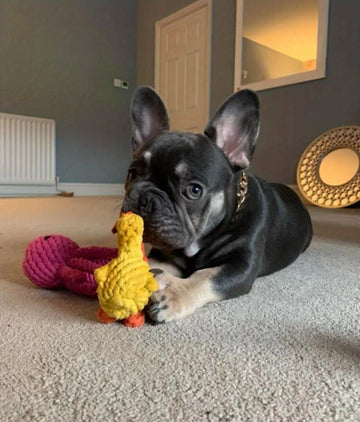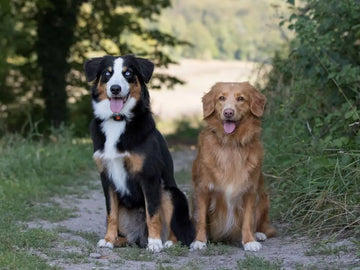As a dog onwers, have you experienced that moment - walking into a room to discover your beloved canine companion has turned your favorite shoe, furniture leg, or remote control into their personal chew toy. As frustrating as these moments can be, chewing is a natural and necessary behavior for dogs of all ages. Understanding why dogs chew and providing appropriate alternatives isn't just about saving your possessions - it's essential for your pet's physical and mental wellbeing.
Understanding the Canine Chewing Instinct
Dogs explore their world through their mouths in ways humans can't fully comprehend. For puppies, chewing helps soothe the discomfort of teething as their adult teeth emerge. For adult dogs, chewing helps keep jaws strong, teeth clean, and minds engaged. Many people mistakenly view chewing as a behavioral problem, when it's actually a fundamental canine need.
"Dogs have co-evolved with humans for thousands of years, but their instinctual behaviors remain," explains Dr. Samantha Wells, veterinary behaviorist. "Chewing serves multiple evolutionary purposes - from maintaining dental health to relieving stress and boredom. The key isn't stopping chewing behavior but directing it appropriately."
When Good Dogs Chew Bad Things
The difference between problematic and healthy chewing often comes down to one factor: appropriate targets. A puppy determinedly working on an appropriate chew toy demonstrates the same natural behavior as one destroying your expensive leather sofa - but with dramatically different consequences.
Common reasons dogs engage in destructive chewing include:
1. Insufficient Exercise and Mental Stimulation
Many modern dogs live relatively sedentary lives compared to their working ancestors. Without adequate physical exercise and mental engagement, dogs often turn to chewing as an outlet for pent-up energy.
2. Separation Anxiety and Stress Relief
For some dogs, chewing becomes an emotional coping mechanism. Dogs experiencing separation anxiety or stress may engage in destructive chewing behaviors, particularly around exit points like doors and windows.
3. Attention-Seeking Behavior
Some clever canines learn that chewing forbidden items results in immediate attention from their humans - even if that attention is negative. This inadvertently reinforces the unwanted behavior.
4. Teething Discomfort
Puppies between 3-7 months experience significant dental changes as their adult teeth emerge. During this period, they have an intensified need to chew to relieve gum discomfort.
Building Your Dog Supplies Arsenal Against Destructive Chewing
Creating an environment that facilitates appropriate chewing while preventing destructive behavior requires thoughtful preparation. A well-stocked collection of dog supplies should include various items designed specifically for safe chewing.
Essential Preventative Measures
Management First: Until your dog reliably chooses appropriate chewing items, physical management remains crucial. This might include crate training, baby gates to restrict access to certain areas, or close supervision during free-roaming time.
Consistency: Every family member must follow the same rules about what dogs can and cannot chew. Confusion leads to frustration for your dog and inconsistent results.
Positive Reinforcement: When you catch your dog chewing an appropriate item, offer genuine praise and occasional treats to reinforce this desirable behavior.
Selecting the Perfect Chew Toys for Dogs
The market offers countless chew options, but not all are created equal regarding safety, durability, and appeal. When building your collection, consider these factors:
Material Safety and Durability
Cheap, poorly constructed toys can break into sharp pieces, posing serious choking and digestive hazards. Always inspect toys regularly for damage and replace them when compromised.
Size Appropriateness
Toys should be large enough that your dog cannot accidentally swallow them whole or get them lodged in their throat. What works for a Chihuahua won't necessarily suit a German Shepherd.
Texture Variety
Dogs, like humans, develop preferences. Some prefer soft, plush items while others gravitate toward hard, rigid chewing surfaces. Providing variety helps you discover what engages your particular pet.
Engagement Factor
The most effective chew toys offer mental engagement beyond simple gnawing. Toys that dispense treats, make interesting sounds, or offer unpredictable movements typically hold interest longer.
Good Chew Toys for Puppies: Special Considerations
Puppies have specific chewing needs that differ from adult dogs. Their developing teeth and jaws require appropriate resistance without excessive hardness that could damage emerging adult teeth.
Teething-Specific Features
Freezable chew toys provide cooling relief for inflamed gums during active teething phases. Textured surfaces with varied ridges and bumps help massage sore gums while satisfying the intense urge to chew.
Growth-Adjusted Options
As puppies rapidly grow, their chewing preferences and abilities evolve. What fascinates a 10-week-old puppy might bore them completely by 16 weeks. Having age-appropriate options ready prevents them from seeking out inappropriate household items.
Dental Development Support
Specially designed puppy dental chews promote healthy tooth alignment and gum development while satisfying the biological need to chew. These often feature softer materials than adult versions while still providing beneficial cleaning action.
The Classics: Time-Tested Chewing Solutions
Certain chew toy designs have proven their worth through generations of dogs. These classics deserve consideration in any comprehensive chewing management plan:
The Kong: Versatility Champion
These hollow rubber toys can be filled with treats, peanut butter, or frozen food mixtures to extend engagement time dramatically. Their unpredictable bouncing pattern also triggers prey drive, making them fascinating even when empty.
Nylabone Products: Texture Variety
With options ranging from soft puppy-specific formulations to virtually indestructible versions for power chewers, this product line offers appropriate choices for dogs throughout their lifespan.
Natural Options: Satisfying Primal Urges
Naturally shed antlers, properly prepared beef bones (never cooked), and specially cured animal parts provide satisfying chewing experiences that closely mimic what ancestral dogs would have encountered. Always supervise natural chews and remove them when they become small enough to swallow.
Innovation in Chew Toy Technology
Modern manufacturing has introduced remarkable innovations to address specific chewing challenges:
The Rubber Tire Dog Chew Toy Revolution
Drawing inspiration from industrial materials, several companies have developed incredibly durable chew toys using modified rubber tire compounds. These toys stand up to even the most determined power chewers while being gentle on teeth and gums.
"The engineering behind these specialized rubber compounds represents a significant breakthrough," notes pet product developer Michael Chen. "We've created toys that maintain the perfect balance between resistance and give, satisfying the dog's need for sustained chewing without damaging dental structures."
These reinforced rubber formulations typically incorporate:
- Special cross-linking polymer structures that resist tearing
- Flavored infusions that maintain interest over time
- Textured surfaces that help remove plaque during chewing sessions
- Flexible construction that prevents broken teeth
Tech-Enhanced Engagement
Some modern chew toys incorporate electronic components that respond to chewing pressure with lights, sounds, or vibrations. These interactive elements can capture attention from dogs who quickly bore of static toys.
Sustainable Materials Movement
Eco-conscious pet parents can now find chew toys made from recycled materials, biodegradable compounds, or renewable resources. These environmentally responsible options perform comparably to conventional toys while reducing planetary impact.
Creating a Comprehensive Chewing Strategy
Successful chew management requires more than simply purchasing appropriate toys. Consider implementing these additional strategies:
Rotation System
Rather than leaving all chew toys available constantly, implement a rotation system. Keep most toys stored away and offer only a few at a time, swapping them every few days. This prevents habituation and maintains novelty.
Strategic Placement
Position appropriate chew toys near favorite resting spots and in areas where inappropriate chewing commonly occurs. This environmental engineering makes choosing correctly easier for your dog.
Enrichment Planning
Schedule regular interactive play sessions using chew toys to teach your dog that these items represent fun engagement opportunities, not just solitary entertainment.
Energy Management
Ensure your dog receives appropriate physical exercise and mental stimulation daily. A tired dog is significantly less likely to engage in problematic chewing behaviors out of boredom or excess energy.
When Professional Intervention Makes Sense
Despite best efforts, some dogs develop persistent destructive chewing habits that require specialized assistance. Consider consulting a professional when:
- Chewing focuses primarily on specific types of objects despite appropriate alternatives
- Destructive behavior occurs exclusively during owner absence
- Chewing accompanies other anxiety symptoms like excessive vocalization, pacing, or elimination issues
- The intensity of chewing seems compulsive or self-injurious
Certified animal behaviorists and veterinary behaviorists can develop tailored intervention plans that address underlying causes rather than just symptoms.
Conclusion: Patience in the Process
Managing canine chewing behavior represents a journey, not a destination. Even well-trained adult dogs occasionally make mistakes, particularly during stressful transitions or when facing new environmental challenges.
The key lies in consistency, appropriate expectations, and genuine understanding of your dog's biological needs. By providing suitable outlets for natural chewing behavior, you foster not just a well-behaved pet but a psychologically fulfilled companion.
Remember that your dog isn't chewing to spite you or because they lack training - they're expressing an innate need that connects them to their evolutionary heritage. By accommodating this need appropriately, you strengthen the human-animal bond while protecting your household possessions.
With the right approach, the frustration of destructive chewing can transform into appreciation for your dog's healthy engagement with appropriate alternatives - a victory for both species in our continuing journey of interspecies understanding.










